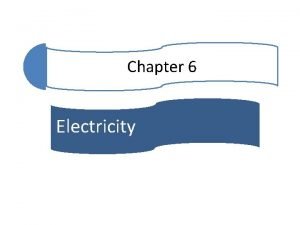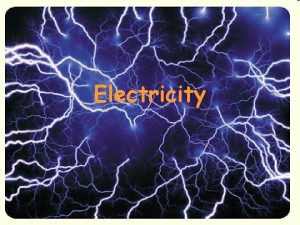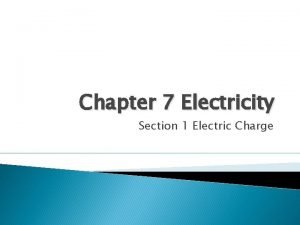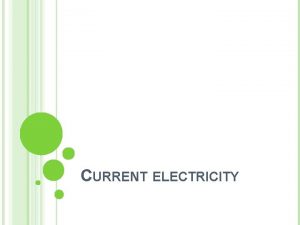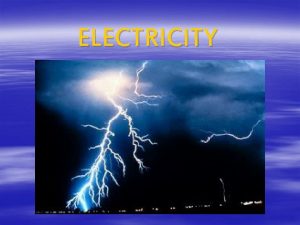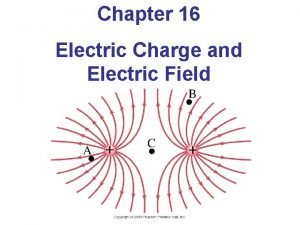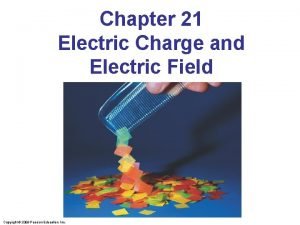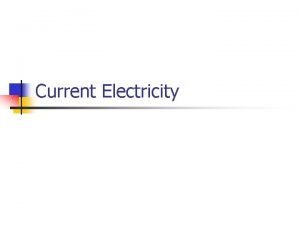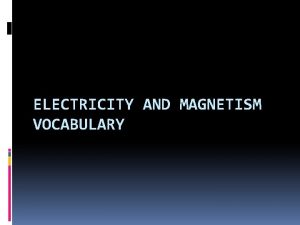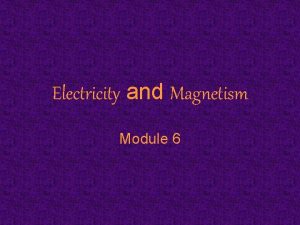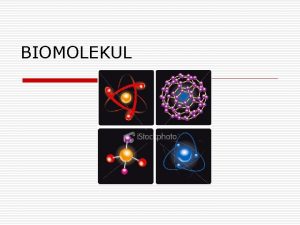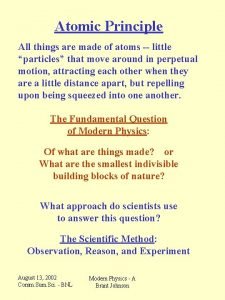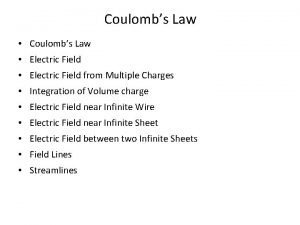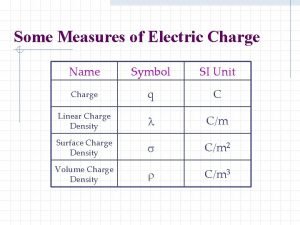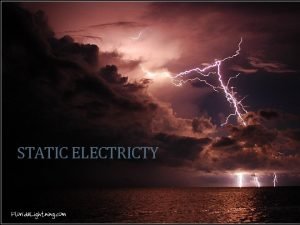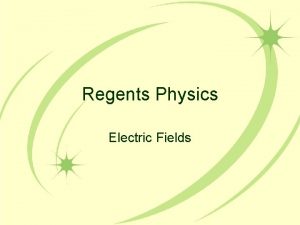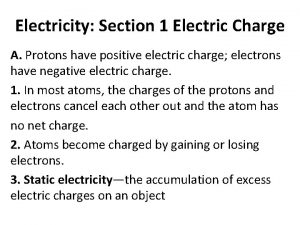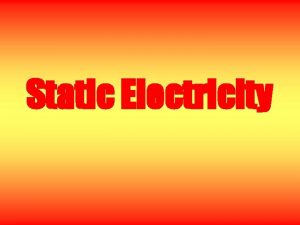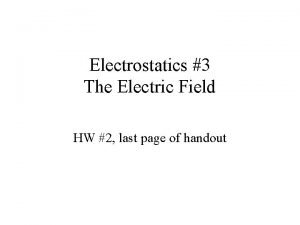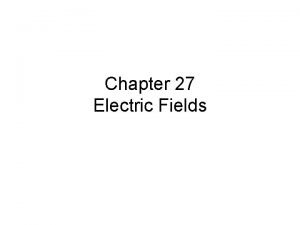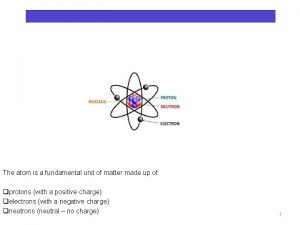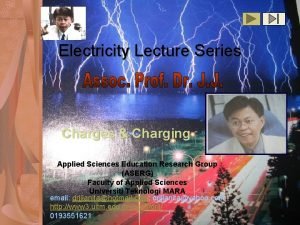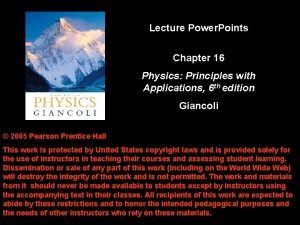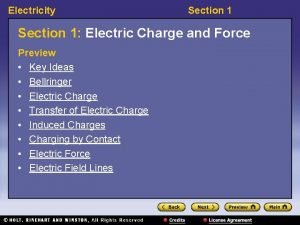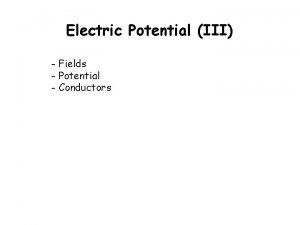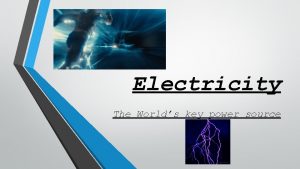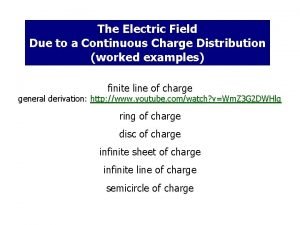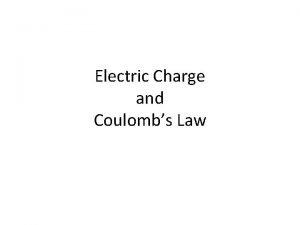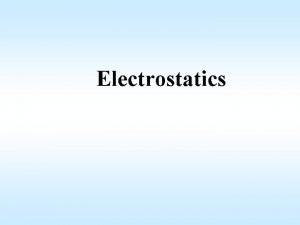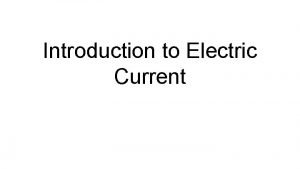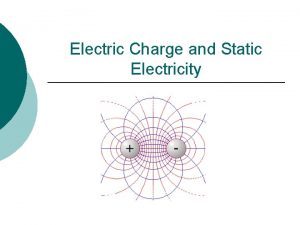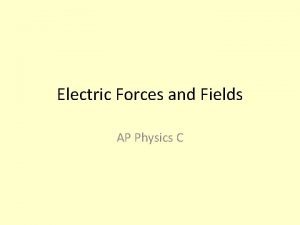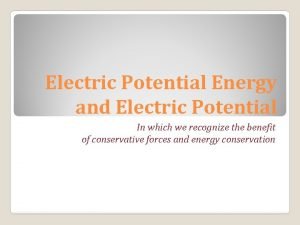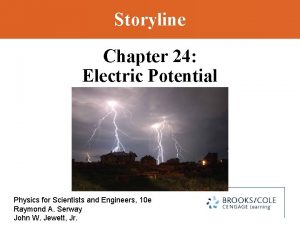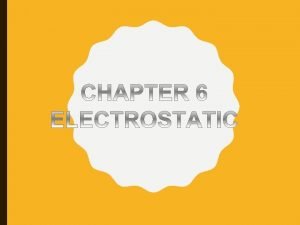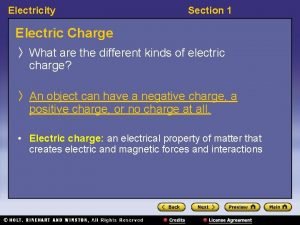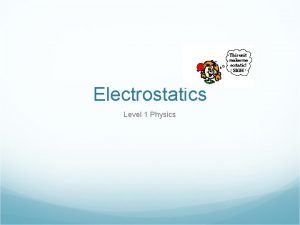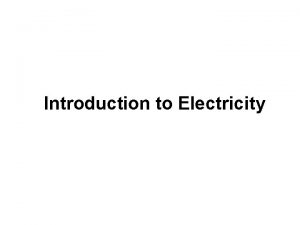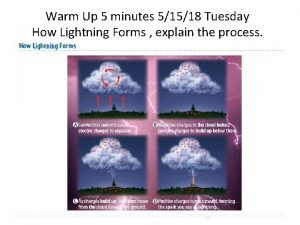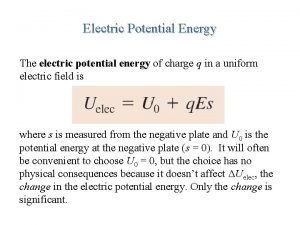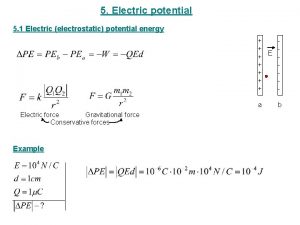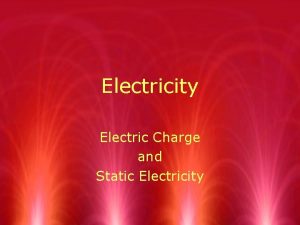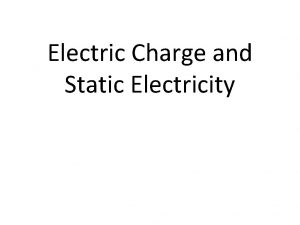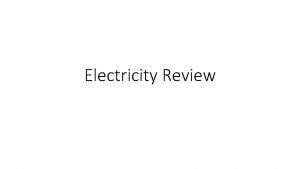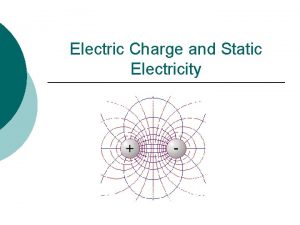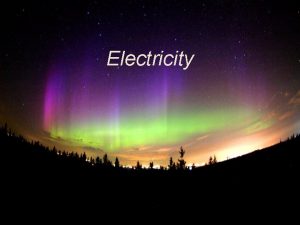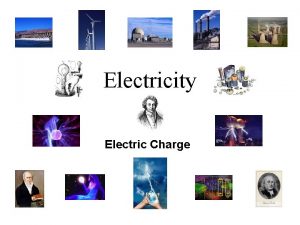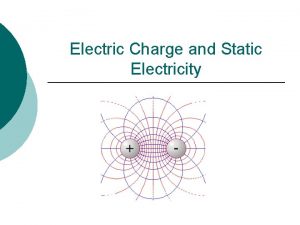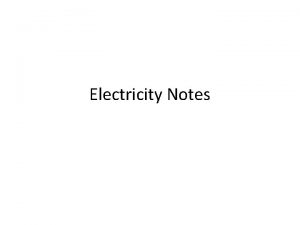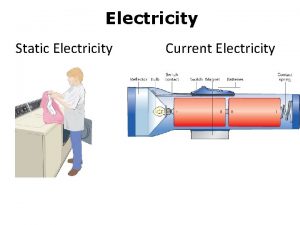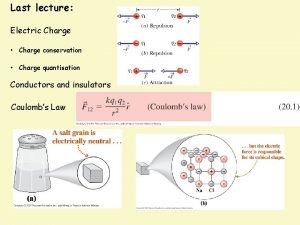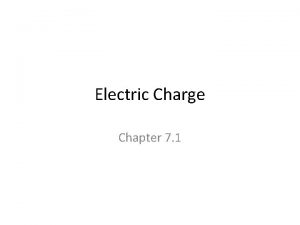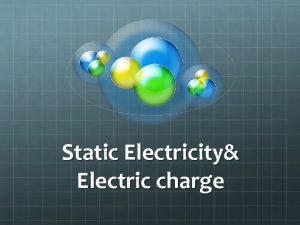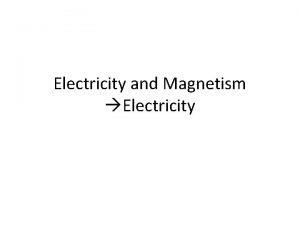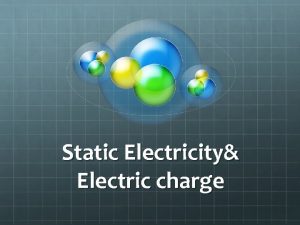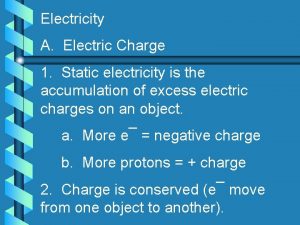ELECTRICITY Electric Charge Atoms are made up of





















































- Slides: 53

ELECTRICITY

Electric Charge § Atoms are made up of 3 particles – – – Neutrons have a neutral charge. Protons have a positive charge. Electrons have a negative charge. § An atom is electrically neutral if the number of electrons EQUALS the number of protons § However, atoms sometimes LOSE or GAIN electrons. § When excess (or extra) electrons are stored, an overall NEGATIVE (-) charge is achieved

“Electrons” clip

Charges § Handy rule : Opposites attract And likes repel

Electric fields § Every electric charge is surrounded by an electric field which can exert a force on objects which come into it. These fields can push or pull over distances

2 types of electricity § Static electricity §Electric current

§ Static electricity is an accumulation of electric charges on an object. Neutral Charge Negative Charge transferred -

Charging objects § Objects can become charged by a variety of methods § 2 ways are – Charging by CONTACT – Charging by INDUCTION

Charging by Contact § Objects touch or rub against each other (contact) and charge is transferred

Charging by Induction § Occurs when a charged object is brought near a neutral object. The charges in the neutral object rearrange themselves and present the illusion of a charge.

§ Once objects are charged, they can then transfer their charge…sometimes, suddenly, in what is called a STATIC DISCHARGE.

“Balloons on the Wall” clip

Conductors and Insulators Conductors = materials which allow excess electrons to easily move through them. Examples : metals, water The Earth also functions as a conductor.

Conductors and Insulators Insulator = a material that doesn’t allow electrons to move through it easily Examples : plastic around wires, wood doors, fiberglass, rubbers Notice what the handles are made of. Why?

“Conductors and insulators” clip

§ A device made up of two thin metal leaves attached to a knobbed metal rod. The leaves can move and hang straight down when not charged. This device is used to detect electric charges. Electroscope

Lightning Large static discharge Air masses move and swirl Top + Bottom - Negative charge induces a + charge on ground (repel e-)

When electrons get close to ground Bottom accumulates enough Electrons in cloud attracted to ground Positive charges are attracted Connection made = lightning

Electric charges move through air collide with atoms/molecules Collisions cause atoms/molecules to emit light

Electrons are ripped off atoms in the air Produce great amounts of heat Powerful sound waves

Warms surrounding air to 25, 000 C (2. 5 x hotter than Sun surface)

Heat causes air in path to expand rapidly sound waves = Thunder

Earth is a large neutral object Connection (conductor) will transfer any excess electric charge “Grounding” – the act of making a connection for an electric charge to go to the Earth (Lightning rods)


“Lightning” clip

“Van de Graff” clip with safety from static discharge

Video quiz static electricity

Resistance § RESISTANCE is the tendency for a material to oppose the flow of electrons. § Causes the ELECTRICAL energy to change into THERMAL energy and LIGHT. § Filament in light-bulb has high resistance so it heats up and glows

§ The amount of resistance is different for each type of conductor. § Resistance is measured in ohms. Its symbol is Ω. This is the Greek letter omega

Resistance in wires § Resistance is caused by electrons running into each other or the walls of the wire. § Resistance is caused by friction which means heat will be present. Longer, thin wires have MORE resistance than short, thick wires

§ The resistance of a material will increase (↑) as the temperature increases (↑) in most conductors. § This is why electrical equipment does not work as well if it has been on for an extended time.

Electric Current § Similar to HEAT which flows from areas of high temps to areas of low temps, ELECTRONS flow from places of high potential energy to places of lower PE. § A negatively charged object has more PE than an uncharged one § When electrons do get to move (like in a spark of static discharge) the potentials become equal and the flow stops.

Comparison of GPE to potential difference Potential Energy (height) 1. 5 V Potential Difference 1. 5 Meters 0. 0 V To Lower Energy The potential difference (voltage) is 1. 5 V.

Electrical Energy Moving electrons in a path is electricity § Electrical Potential Difference (v) is measured in Volts § The rate of moving electric charges, Electric Current (I), is measured in Amperes § Resistance or opposition to the movement of the energy is called Resistance (R). § I=V R

Circuits – 2 types § Series circuits are the most simple. § One COMPLETE (1) path for the current to travel. § Contains an energy source, a path, and a load (something for it to do, like a lamp)

Circuits – 2 types § Parallel circuits provide more than one path for the current to travel. § Most circuits are parallel, since if one lamp goes out, the others can stay lit.

Which switches, if opened, will cause the light bulb to stop glowing? F. Q G. R It is the only H. S switch in J. T series to both the battery and light.

USE THE FORMULA SHEET!! § What is the current in a copper wire that has a resistance of 2 ohms and is connected to a 9 volt electrical source? A. B. C. D. 0. 22 amp 4. 5 amps 11. 0 amps 18. 0 amps V = I R so, 9 V = I x 2 ohms or 4. 5 amps

Electrocution



Historical perspective on Electricity § 600 B. C. Thales of Miletus writes that the Greeks had discovered that rubbing fur on certain substances such as amber would cause an attraction between the two. The amber would attract light things such as hair and if rubbed long enough produced a spark.

250 B. C. § Baghdad Battery – Object found in Iraq in 1938 (and dated back to 250 BC) resembles a galvanic cell and is thought to have been used for electroplating – Electroplating is the use of electricity to cover something with certain metals

1550 A. D. § Italian physician Girolamo Cardano in his De Subtilitate distinguishes difference between electrical and magnetic forces

1600 A. D. § English scientist William Gilbert writes De Magnate coined the Latin word electricus from the Greek word ηλεκτρον (elektron), § Ηλεκτρον means “amber” in Greek § English words electric and electricity came from

§ 1660 A. D. Otto von Guericke invents an electrostatic generator § 1675 A. D. Robert Boyle determines that electric forces can attract or repel through a vacuum

§ 1729 A. D. Stephen Gray classifies materials as either conductors or insulators § 1729 A. D. C. F. Du Fay identifies positive and negative charges

1752 A. D. § Benjamin Franklin legend says that he conducted famous, yet extremely dangerous experiment of flying kite with metal key attached during lightning storm linking lightning with electricity. He saw that the fibers on the string were standing up and also received a shock from the key when he touched it.

§ Franklin invented the lightning rod to protect structures by directing the charge to the ground. • Georg Wilhelm Richmann of St. Petersburg, Russia died performing kite experiment in 1753

Nikola Tesla Michael Faraday Thomas Edison



 Insidan region jh
Insidan region jh Chapter 6 electricity section 1 electric charge answers
Chapter 6 electricity section 1 electric charge answers Section 1 electric charge crossword puzzle answers
Section 1 electric charge crossword puzzle answers Electricity section 1 electric charge
Electricity section 1 electric charge Electrons flowing
Electrons flowing Difference between charge and electric charge
Difference between charge and electric charge Units of charge
Units of charge Chapter 21 electric charge and electric field
Chapter 21 electric charge and electric field Chapter 21 electric charge and electric field
Chapter 21 electric charge and electric field Chapter 21 electric charge and electric field
Chapter 21 electric charge and electric field Periodic table regents
Periodic table regents Current electricity gif
Current electricity gif How are static electricity and current electricity alike
How are static electricity and current electricity alike Static electricity and current electricity
Static electricity and current electricity Are cells made up of atoms
Are cells made up of atoms Bagian terkecil penyusun makhluk hidup
Bagian terkecil penyusun makhluk hidup Nuclear fission
Nuclear fission How was electricity discovered
How was electricity discovered How is electricity produced
How is electricity produced Electric field for infinite line charge
Electric field for infinite line charge What is amber in electricity
What is amber in electricity Unit of charge
Unit of charge Charging by conduction
Charging by conduction Electric field lines about a point charge extend
Electric field lines about a point charge extend Protons electric charge
Protons electric charge Stationary electric charge
Stationary electric charge Force on charge in electric field
Force on charge in electric field Electric field at a point formula
Electric field at a point formula Charge on proton
Charge on proton What is electric charge measured in
What is electric charge measured in Charging by contact
Charging by contact Units of charge
Units of charge Section 1 electric charge
Section 1 electric charge Electric field of a finite line charge
Electric field of a finite line charge What is electricity
What is electricity Electric field of continuous charge distribution
Electric field of continuous charge distribution Columbs law
Columbs law Chapter 17 section 1 electric charge and force answer key
Chapter 17 section 1 electric charge and force answer key Coulomb to volt
Coulomb to volt What is the continuous flow of electric charge?
What is the continuous flow of electric charge? Static electricity examples
Static electricity examples Electric field of line charge
Electric field of line charge Electric potential energy
Electric potential energy Electric field of a finite line charge
Electric field of a finite line charge Electric charge
Electric charge Properties of coulomb's law
Properties of coulomb's law Section 1 electric charge crossword puzzle answers
Section 1 electric charge crossword puzzle answers Electric charge
Electric charge Electric charge
Electric charge Coulomb symbol
Coulomb symbol Joules per coloumb
Joules per coloumb Electric charges and electric forces lesson outline
Electric charges and electric forces lesson outline Potential energy of an electric field
Potential energy of an electric field Electric potential is
Electric potential is

